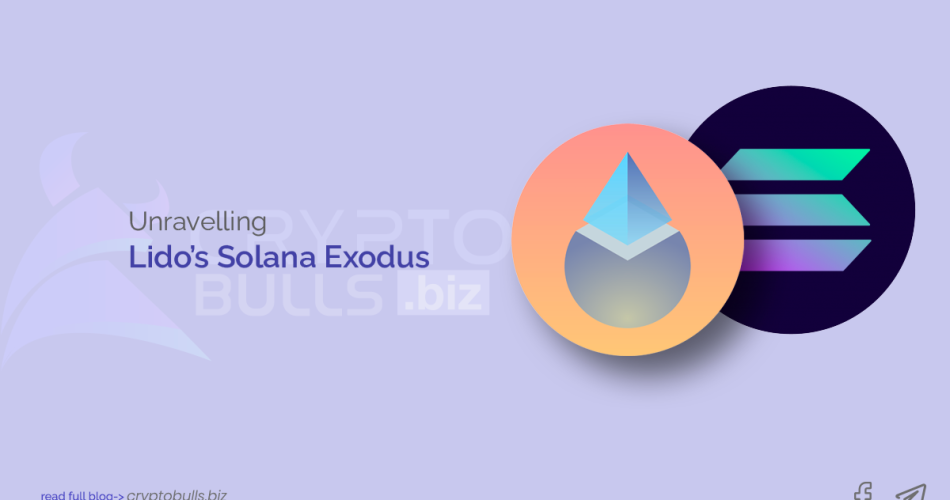Unravelling Lido’s Solana Exodus: The Community Vote that Reshaped Solana’s Crypto Ecosystem
In a landmark decision that has sent ripples through the DeFi landscape, over 92% of Lido token holders have voted in favour of sunsetting the Solana project. This move marks a significant shift in strategy for Lido Finance, as it discontinues new staking requests for Solana tokens. Before this announcement, the Total Value Locked (TVL) of Solana (SOL) on Lido stood at a robust $55.8 million, contributing to an overall TVL of $313 million for Solana. However, the aftermath of the announcement saw a precipitous drop of over $100 million, bringing Solana’s TVL down to $210 million. In this article, we delve into the reasons behind Lido Finance’s decision to phase out Solana from its liquid staking and explore the potential impact of this move on the Solana ecosystem.
Genesis of Lido on Solana
Lido Finance is a decentralized liquid staking platform that allows stakeholders to stake their assets without having to sacrifice the liquidity or lock them up. It was introduced to the DeFi ecosystem in 2020 and has quickly become one of the most popular Liquid staking protocols in the world. Lido($stETH) has dominated the Liquid staking sector market since its launch receiving an inflow of $2.4 billion this year only.
In March 2022, Lido Finance acquired Chorus One which is a Solana staking provider and launched Lido on Solana. The Lido on Solana was a part of the Lido Ecosystem Grants Operation (LEGO) project which was aimed to expand the presence of Lido across various staking networks. Liquid staking of Solana was launched six months after the proposal of Chorus One was approved by Lido DAO. It allowed users to stake their SOL tokens and receive liquid ERC-20 (stSOL) tokens in return.
Lido on Solana was launched in response to the growing demand for liquid staking solutions on the Solana SOL network. Solana (SOL) is a high-performance blockchain that is capable of processing 3000 transactions per second (TPS) on average but it does support a theoretical peak capacity of 65000 transactions per section because of its built-in mechanism for synchronizing time across nodes. This made Solana a popular choice for decentralized finance (DeFi) protocols and decentralized apps (DApps).
Lido on Solana solved the problem of Solana staking requiring users to lock up their Solana SOL tokens for a longer period by allowing them to stake their tokens and receive stSOL tokens in return. These tokens are liquid and can be traded, lent and borrowed freely. It was well-received by the Solana community, and Lido on Solana quickly became one of the largest staking providers on the Solana network.
But in September 2023 Lido DAO voted to sunset the Lido on Solana project. This decision was made due to unstable financials, slow fees, and concerns about the centralization of the Solana network. However, due to some organizational changes at Chorus One, a proposal was submitted to transfer the ownership of the Lido on Solana project to a P2P validator paving the way for a new era of Lido’s liquid staking on Solana.
Lido DAO’s Deliberation
The decision to Phase out Lido on Solana was not an easy one for the Lido DAO but it might have been the right one for Lido DAO and its users. Lido DAO is always committed to providing its users with a safe and secure way to stake their assets and earn rewards by staking. Phasing out Lido on Solana helped Lido DAO to focus on its Ethereum Staking program and other initiatives that align more with its values and missions. This decision was made after an extensive decision within the Lido DAO and a community vote with the majority of the Lido token holders (over 92%) favouring the decision to sunset the project.
Several reasons contributed to this decision including financial constraints, technical challenges, and centralization concerns.
- Revenue Shortfall: Lido on Solana was unable to generate enough revenue to cover its costs. The project invested $700,000 but only received a revenue of $220,000, resulting in a loss of $484,000. This was due to the low fees charged for Solana Staking and the relatively small size of the Solana Staking market.
- Technical Challenges: Lido on Solana faced several technical challenges including issues with performance and outages. Users were subject to slow fees due to the immaturity of the Solana Ecosystem and the high demand for Solana staking service.
- Concerns over Centralization: Lido DAO was also concerned about the centralization of the Solana network. Solana is controlled by a small number of large validators that raise a risk of manipulation and censorship.
- Competition and Reputation Risk: Lido on Solana also had to face competition from other liquid staking providers like Everstake and Stakefish. If Lido on Solana had continued to operate at a loss, it could have significantly damaged the reputation of the Lido protocol.
Lido DAO’s Future Focus
The decision was made by Lido DAOs to discontinue their operations on the Solana blockchain and make a significant strategic shift by shifting their focus and resources to Ethereum and Polygon Staking. The proposal of sunsetting Lido on Solana was initially introduced by Lido’s P2P team citing financial sustainability issues and low revenue generated by the protocol on Solana.
Lido DAO now has shifted its focus to capitalize on the growing demand for liquid staking on Ethereum and Polygon. Lido DAO is already leading the liquid staking protocol on Ethereum with over $7 billion in staked assets. By expanding its protocol with Polygon, Lido DAO is set to open new markets for its services, developing new features and products to attract new users to its liquid staking protocol making it well-positioned to become the leading liquid staking protocol in the World. This shift is likely due to several factors including
- Ethereum is the largest blockchain by market capitalization.
- Ethereum has a large and active community of users and developers.
- Polygon on the other hand is a layer-2 solution for Ethereum that offers faster and cheaper transactions.
- Also, Lido DAO has a strong track record of significant success with Ethereum and Polygon.
Impact on the Solana Ecosystem
Solana is a high-performance blockchain platform designed for decentralization applications and crypto-currencies. It was introduced in March 2020 by the Solana Foundation. It uses a combination of Proof of Stake (PoS) and timestamped transactions to improve blockchain scalability.
Let’s look at some of the potential impacts on the Solana Ecosystem:
- Immediate Impacts:
- Decrease in the total value locked TVL in the Solana ecosystem.
- Decrease in the number of node operators in the Solana ecosystem.
- End of Lido on Solana frontend support.
- Decrease in the amount of SOL tokens staked via Lido.
- Long-Term Impacts:
- Impact on the Security and Performance of the Solana Network
- Lido being the major player in the ecosystem can also have a broader impact on the Solana ecosystem
- Opportunities for other liquid staking providers on Solana
It is important to note that the full impact of Lido Finance’s decision to sunset Lido on Solana is still not clear yet. But this event having a ripple effect on the Solana Ecosystem is significant as after this announcement TVL of Solana Dropped from $313 million to $210 million.
Lido’s History with Other Blockchains
Lido, a decentralized liquid staking protocol has interacted with multiple blockchains to leverage their unique features and expand their offerings, including Ethereum, Solana, Kusama, and Polkadot. However, navigating the blockchain ecosystem comes with its challenges. Lido’s journey across these blockchains serves as a testament to the dynamic nature of the DeFi space and highlights both its opportunities and challenges which led to its decision to discontinue its operations on some of these blockchains.
Ethereum:
Lido has seen significant success on the Ethereum blockchain. With its new Shapella Upgrade, it into a fully functional proof-of-stake blockchain.Lido($stETH) has dominated the LSD market since its launch, receiving an inflow of $2.4 billion this year only. Lido Finance’s growth has been prominent by allowing investors to stake their ether ETH and earn rewards while also maintaining liquidity by receiving stETH tokens that are tradable.
Kasuma:
Lido Finance decided to enter the Kasuma blockchain in February 2022 to leverage its unique features, growing ecosystem, and interoperability with other blockchains. Kasuma is also a canary network for Polkadot, meaning that new features and upgrades are tested on Kasuma before being deployed on Polkadot. However, Lido Finance also decided to discontinue its operations with Kasuma Blockchain and exit the blockchain in August 2023. This decision was made after considering several changes including market conditions, protocol growth, limited capacity, and prior alignment. Although the exit was a controversial decision some of the members of the Lido community expressed disappointment.
Polkadot:
Polkadot is a leading Layer 1 blockchain with a strong focus on security and governance which makes it a good platform for Lido to offer its liquidity staking services to users who are looking for more secure and reliable options. But similar to Kusama, Lido Finance decided to discontinue its operations on Polkadot and exit the blockchain in August 2023 after first entering in May 2022.
Conclusion
Lido Finance’s journey is a testament to the dynamic nature of the DeFi landscape. The decision to sunset Lido on Solana, driven by a multitude of factors ranging from revenue shortfalls to technical challenges, underscores the importance of adaptability in this rapidly evolving space. Despite these challenges, Lido remains at the forefront of the liquid staking industry, continually innovating and expanding its reach.
The impact of Lido’s decisions on the Solana ecosystem serves as a reminder of the interconnectedness of the DeFi world. As Lido continues to navigate this complex landscape, its journey highlights the potential of liquid staking to revolutionize PoS blockchains. In the end, it’s not just about the destination, but also about the journey – a journey marked by resilience, innovation, and a relentless pursuit of a more decentralized future.


